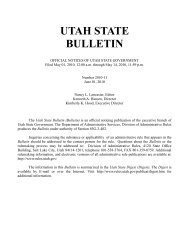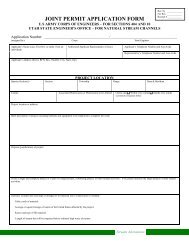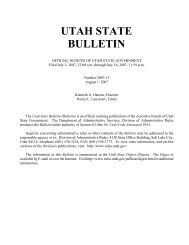Utah State Bulletin, January 15, 2012, Vol. 2012, No. 2
Utah State Bulletin, January 15, 2012, Vol. 2012, No. 2
Utah State Bulletin, January 15, 2012, Vol. 2012, No. 2
Create successful ePaper yourself
Turn your PDF publications into a flip-book with our unique Google optimized e-Paper software.
DAR File <strong>No</strong>. 35610NOTICES OF PROPOSED RULES"employee," "worker," or "operative" as defined in Section 34A-2-104 who:(i) works at least 30 hours per calendar week; and(ii) meets employer eligibility waiting requirements forhealth care insurance which may not exceed the first day of thecalendar month following 90 days from the date of hire.(d) "<strong>State</strong>" means the state of <strong>Utah</strong>.R131-13-4. Applicability of Rule.(1) Except as provided in Subsection R131-13-4(2)below, R131-13 applies to all design or construction contractsentered into by the Board or the executive director, or on behalf ofthe Board, on or after July 1, 2009, and(a) applies to a prime contractor if the prime contract is inthe amount of $1,500,000 or greater; and(b) applies to a subcontractor if the subcontract, at anytier, is in the amount of $750,000 or greater.(2) Rule R131-13 does not apply if:(a) the application of this Rule R131-13 jeopardizes thereceipt of federal funds;(b) the contract is a sole source contract; or(c) the contract is an emergency procurement.(3) This Rule R131-13 does not apply to a change orderas defined in Section 63G-6-103, or a modification to a contract,when the contract does not meet the initial threshold required bySubsection R131-13-4(1).(4) A person who intentionally uses change orders orcontract modifications to circumvent the requirements ofSubsection R131-13-4(1) is guilty of an infraction.R131-13-5. Contractor to Comply with Section 63C-9-403.All contractors and subcontractors that are subject to therequirements of Section 63C-9-403 shall comply with all therequirements, penalties and liabilities of Section 63C-9-403.R131-13-6. <strong>No</strong>t Basis for Protest or Suspend, Disrupt, orTerminate Design or Construction.(1) The failure of a contractor or subcontractor to providequalified health insurance coverage as required by this Rule R131-13 or Section 63C-9-403:(a) may not be the basis for a protest or other action froma prospective bidder, offeror, or contractor under Section 63G-6-801or any other provision in Title 63G, Chapter 6, Part 8, Legal andContractual Remedies; and(b) may not be used by the procurement entity or aprospective bidder, offeror, or contractor as a basis for any action orsuit that would suspend, disrupt or terminate the design orconstruction.R131-13-7. Requirements and Procedures a Contractor MustFollow.A contractor, including consultants and designers, mustcomply with the following requirements and procedures in order todemonstrate compliance with Section 63C-9-403.(1) Demonstrating Compliance with Health InsuranceRequirements. The following requirements must be met by acontractor, including consultants, designers and others undercontract with the Board or the executive director that is subject tothe requirements of Rule R131-13 no later than the time the contractis entered into or renewed:(a) demonstrate compliance by a written certification tothe executive director that the contractor has and will maintain forthe duration of the contract an offer of qualified health insurancecoverage for the contractor's employees and the employees'dependents; and(b) the contractor shall also provide such writtencertification prior to the execution of the contract, in regard to allsubcontractors, including subconsultants, at any tier that are subjectto the requirements of Rule R131-13.(2) Recertification. The executive director shall have theright to request a recertification by the contractor by submitting awritten request to the contractor, and the contractor shall so complywith the written request within ten working days of receipt of thewritten request; however, in no case may the contractor be requiredto demonstrate such compliance more than twice in any 12-monthperiod.(3) Demonstrating Compliance with ActuariallyEquivalent Determination. The actuarially equivalent determinationrequired by Subsection[s] 63C-9-403(1)(c)[(i) and (iii)] and definedin Section 26-40-1<strong>15</strong> is met by the contractor if the contractorprovides the executive director with a written statement of actuarialequivalency from either the <strong>Utah</strong> Insurance Department; an actuaryselected by the contractor; or the contractor's insurer; or anunderwriter who is responsible for developing the employer group'spremium rates.For purposes of this [Subsection]Rule R131-13-7(3),actuarially equivalency is achieved by meeting or exceeding [any ofthe following:(a) As]the requirements of Section 26-40-1<strong>15</strong> which arealso delineated on the DFCM website athttp://dfcm.utah.gov/downloads/Health%20Insurance%20Benchmark.pdf.[, a health benefit plan and employercontribution level with a combined actuarial value at leastactuarially equivalent to the combined actuarial value of thebenchmark plan determined by the Children's Health InsuranceProgram under Subsection 26-40-106(2)(a), and a contribution levelof 50% of the premium for the employee and the dependents of theemployee who reside or work in the <strong>State</strong>, in which:(i) The employer pays at least 50% of the premium forthe employee and the dependents of the employee who reside orwork in the <strong>State</strong>; and(ii) for purposes of calculating actuarial equivalencyunder this Subsection R131-13-7(3)(a):(A) rather than the benchmark plan's deductible, and thebenchmark plan's out-of-pocket maximum based on income levels,the deductible is $750 per individual and $2,250 per family; and theout-of-pocket maximum is $3,000 per individual and $9,000 perfamily;(B) dental coverage is not required; and(C) other than Subsection 26-40-106(2)(a), the provisionsof Section 26-40-106 do not apply; or(b)(i) is a federally qualified high deductible health planthat, at a minimum, has a deductible that is either;(A) the lowest deductible permitted for a federallyqualified high deductible health plan; orUTAH STATE BULLETIN, <strong>January</strong> <strong>15</strong>, <strong>2012</strong>, <strong>Vol</strong>. <strong>2012</strong>, <strong>No</strong>. 2 25


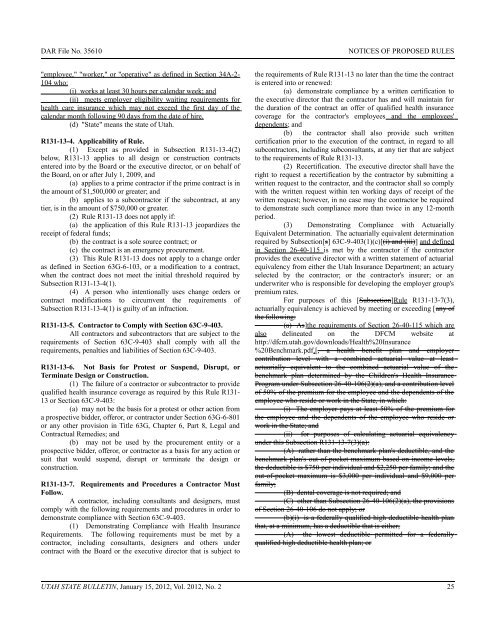
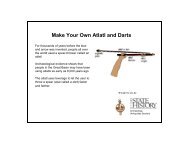
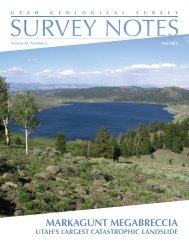
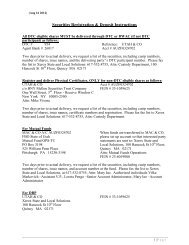
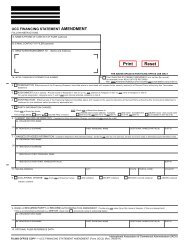
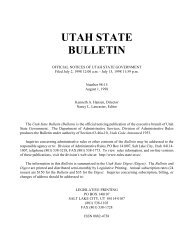
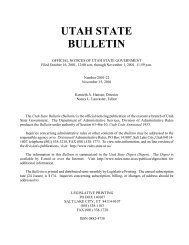

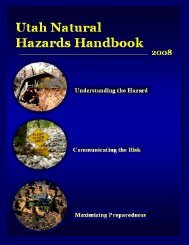
![Lynx avoidance [PDF] - Wisconsin Department of Natural Resources](https://img.yumpu.com/41279089/1/159x260/lynx-avoidance-pdf-wisconsin-department-of-natural-resources.jpg?quality=85)
